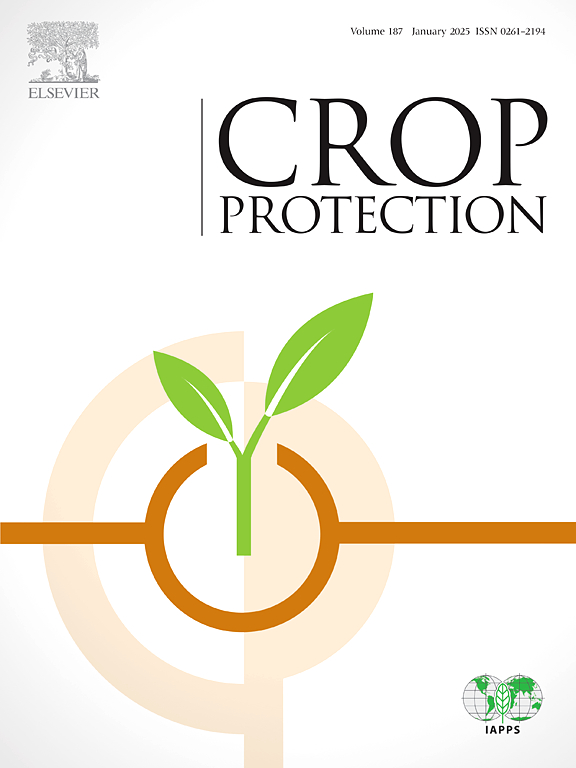Weed plant species associated with the population increase of carabid beetles
IF 2.5
2区 农林科学
Q1 AGRONOMY
引用次数: 0
Abstract
Carabid beetles (Coleoptera: Carabidae) are important biocontrol agents of insect pests and weeds worldwide. Despite this, few studies have investigated weed seed-consuming carabids in Latin America. We studied the relationship between the abundance of weed plants and the population size of carabids in five agroecosystems located in four municipalities (Jaboticabal, Guaíra, Gavião Peixoto, and Descalvado) in northeastern São Paulo state, Brazil. The weed plants comprised a strip of weedy vegetation between a forest fragment, a soybean/maize field, or an orange orchard. Carabid beetles and weeds were sampled with pitfall traps and a square metal frame, respectively, and multiple regression analysis was used to associate the carabids and weed plants. Of the 921 individuals of 18 carabid species captured,与瓢虫种群增加有关的杂草植物种类
瓢虫(鞘翅目:瓢虫科)是世界范围内重要的害虫和杂草生物防治剂。尽管如此,很少有研究调查了拉丁美洲吸食杂草种子的瓢虫。研究了巴西圣保罗州东北部4个市(Jaboticabal、Guaíra、gavi o Peixoto和Descalvado) 5个农业生态系统中杂草植物丰度与瓢虫种群大小的关系。杂草植物包括森林碎片、大豆/玉米田或橘子果园之间的杂草植被带。采用陷阱诱捕法和方形金属框架法分别对瓢虫和杂草进行取样,并采用多元回归分析对瓢虫和杂草植物进行关联分析。在捕获的18种瓢虫921只中,以basaris basistriata Chaudoir、Selenophorus seriatoporus Putzeys、Pentacomia cupricollis (kolar)和Tetracha brasiliensis (Kirby)数量最多。在杂草方面,共鉴定出11科27种,以菊科和禾本科为主。本研究表明,杂草物种可以促进以食食性和掠食性甲虫为主的瓢虫种群的增加。禾科植物与瓢虫种群的增加关系最为密切。[4](野生)紫竹草,和卧绿藻(禾本科),羊尾草(L.)Millsp。大戟科(Euphorbiaceae)、香柏科(Cyperus rotundus L.)和巴西理查达(Richardia brasiliensis Gomes)与锦鲤的相关性最高。这些发现为研究吞食杂草种子的瓢虫和为瓢虫提供避难所的杂草提供了线索。这些领域的进展对可持续杂草管理至关重要。
本文章由计算机程序翻译,如有差异,请以英文原文为准。
求助全文
约1分钟内获得全文
求助全文
来源期刊

Crop Protection
农林科学-农艺学
CiteScore
6.10
自引率
3.60%
发文量
200
审稿时长
29 days
期刊介绍:
The Editors of Crop Protection especially welcome papers describing an interdisciplinary approach showing how different control strategies can be integrated into practical pest management programs, covering high and low input agricultural systems worldwide. Crop Protection particularly emphasizes the practical aspects of control in the field and for protected crops, and includes work which may lead in the near future to more effective control. The journal does not duplicate the many existing excellent biological science journals, which deal mainly with the more fundamental aspects of plant pathology, applied zoology and weed science. Crop Protection covers all practical aspects of pest, disease and weed control, including the following topics:
-Abiotic damage-
Agronomic control methods-
Assessment of pest and disease damage-
Molecular methods for the detection and assessment of pests and diseases-
Biological control-
Biorational pesticides-
Control of animal pests of world crops-
Control of diseases of crop plants caused by microorganisms-
Control of weeds and integrated management-
Economic considerations-
Effects of plant growth regulators-
Environmental benefits of reduced pesticide use-
Environmental effects of pesticides-
Epidemiology of pests and diseases in relation to control-
GM Crops, and genetic engineering applications-
Importance and control of postharvest crop losses-
Integrated control-
Interrelationships and compatibility among different control strategies-
Invasive species as they relate to implications for crop protection-
Pesticide application methods-
Pest management-
Phytobiomes for pest and disease control-
Resistance management-
Sampling and monitoring schemes for diseases, nematodes, pests and weeds.
 求助内容:
求助内容: 应助结果提醒方式:
应助结果提醒方式:


